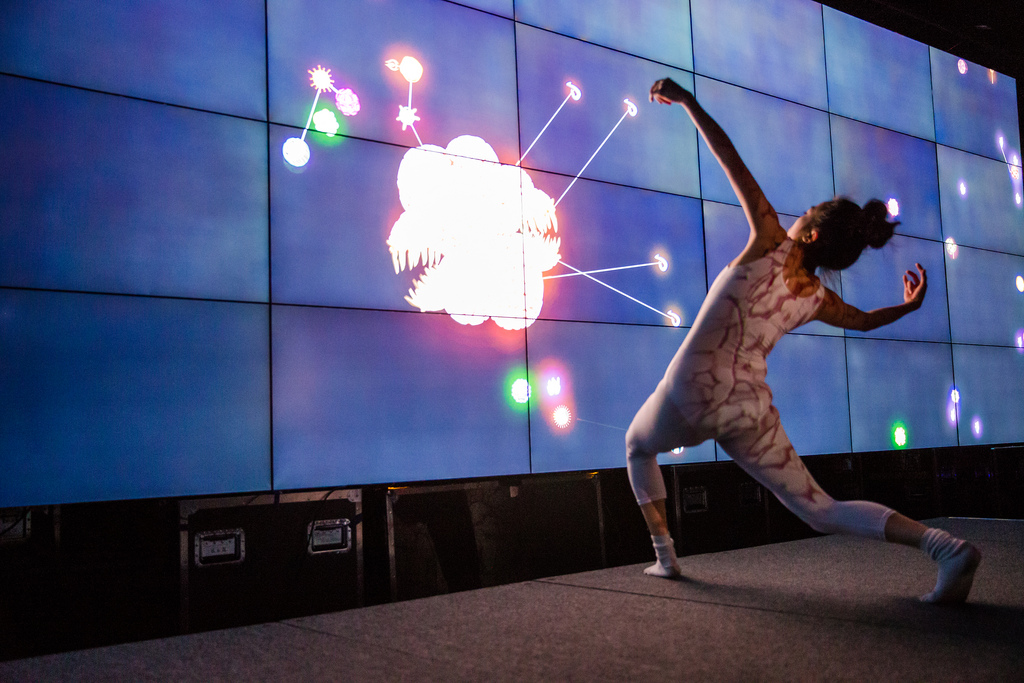Qualcomm Institute Celebrates New Name at Research Open House
May 23, 2013 / By Tiffany Fox, (858) 246-0353, tfox@ucsd.edu
San Diego, Calif., May 23, 2013 — There’s always something new going on at UC San Diego’s Atkinson Hall, but in late May, some of its staff, faculty and students were celebrating a new identity.
|
"It can be difficult to tell the whole story about an institute of this size, and talk alone does not do it justice," said Qualcomm Institute director Ramesh Rao. "The campus and regional communities cannot get a full sense of our scope and size until they come experience the Qualcomm Institute in person. We hope that this Research Open House will open a lot of eyes to the research we do here, and the many ways for industry and non-profit partners as well as individual donors to interact with and support the institute's mission."
The free event began with a plenary session led by some of the key players who formed Calit2 more than a decade ago, as well as a new cadre of leaders charged with carrying on its legacy. Speakers included UCSD Chancellor Pradeep K. Khosla, Former U.S. Representative Lynn Schenk, Qualcomm Chairman and CEO Paul Jacobs, Qualcomm founder and Chair Emeritus Irwin Jacobs, CONNECT president Duane Roth, Calit2 Director Larry Smarr, and Qualcomm Institute Director Ramesh Rao.
A research open house followed and featured rotating 20-minute presentations and ongoing demos in QI labs. Some of the institute’s best-known research spaces showcased their latest and greatest breakthroughs, from the technologies that have evolved in the Nano3 cleanrooms to the advances in digital archaeology emerging from the Center of Interdisciplinary Science in Art, Architecture and Archaeology (CISA3). In some of the largest labs -- such as the Wireless Communications Laboratories and the Immersive and Large-Scale Visualization Facilities -- special presentations began at the top and bottom of each hour, running for 20 minutes each.
A cinematic showcase of super high-resolution 4K videos — including short videos by students in UCSD’s digital cinema course — were shown in the Calit2 Auditorium. Subsequently, a series of quickfire, 4-minute presentations by UC San Diego faculty introduced the public to progress on their current research projects funded by the Calit2 Strategic Research Opportunities (CSRO) grants, which address Calit2’s four key research thrusts: Culture, Environment, Health and Energy.
The top off the celebration, the Calit2 Initiative for Digital Exploration of Arts & Sciences (IDEAS) staged a participatory performance of the work Ad Infinitum3, which recently held its premiere as part of the IDEAS performance series. The performance consisted of a 55-player video game in the Calit2 Theater, allowing anyone with an HTLM5-equipped smartphone, tablet or iPod to fully control their own visually and aurally unique in-game character. The play was ‘staged’ in three acts, with each act being a different game that explores the notions of individuals, families, and societies, and the journeys and relationships between each of them. The audience’s actions determined the outcome of the game, which was accompanied by an original musical score created with four Gameboys.
For a full event agenda, visit the event listing.
The Qualcomm Institute's new name recognizes the critical role Qualcomm, and more recently its affiliated Qualcomm Foundation, have played in Calit2 since the State of California created Calit2 and three other technology institutes spread across nine University of California campuses. During the tenure of Irwin Jacobs, the Company committed $15 million in support to the institute for its first five years. Gifts to Calit2 since then (including recent grants from the Qualcomm Foundation) have pushed Qualcomm’s philanthropic support of Calit2 to just under $26 million over the past 12 years.
"We felt it was important to name the UC San Diego division of Calit2 after Qualcomm and the Qualcomm Foundation because of their corporate, philanthropic support for curiosity-driven research," said Rao. "Traditionally, companies tended to just recruit graduates or sponsor research on campus, but we are seeing increased interest in philanthropic giving from companies, and Qualcomm led the way."
Related Links
Multidisciplinary Research Institute at UC San Diego Named in Honor of Qualcomm
Media Contacts
Tiffany Fox, (858) 246-0353, tfox@ucsd.edu


